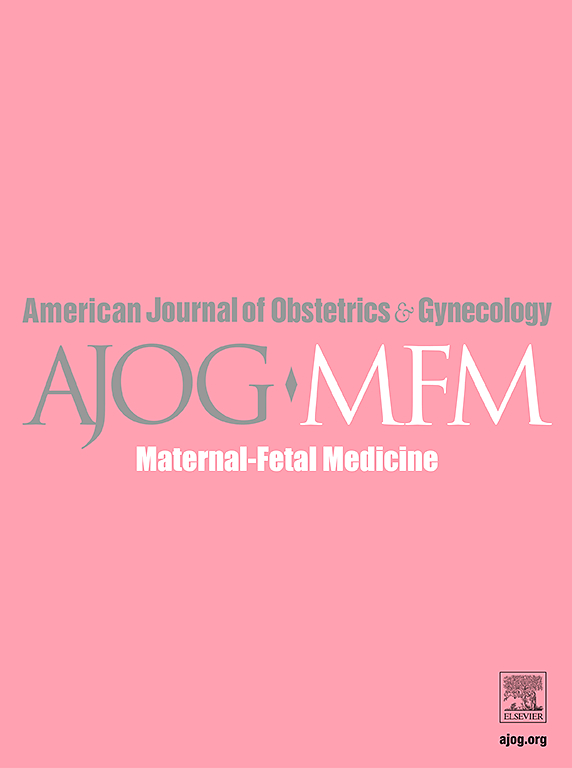The feasibility and effectiveness of using an adhesion barrier in preventing dysmenorrhea, pain, and niche-related problems after cesarean sections: a multicenter randomized pilot study
IF 3.1
2区 医学
Q1 OBSTETRICS & GYNECOLOGY
American Journal of Obstetrics & Gynecology Mfm
Pub Date : 2025-07-18
DOI:10.1016/j.ajogmf.2025.101742
引用次数: 0
Abstract
Background
A cesarean scar can lead to various gynecological complaints, including abdominal pain, dysmenorrhea, postmenstrual spotting, and unexplained secondary infertility. The ethiology of the development of a niche is currently not clear. A possible hypothesis is the involvement of vesicouterine adhesions formed after the cesarean section.
Objective
This study explores the feasibility of a randomized controlled trial assessing the effectiveness of an adhesion barrier on the uterine wound in women undergoing their first cesarean section on gynecological symptoms and the presence of adhesions evaluated by transvaginal ultrasound (TVUS).
Study design
A multicenter randomized pilot study was performed on women undergoing their first cesarean section. They were randomly allocated to the application of the adhesion barrier 4DryField® PH after uterine closure or no adhesion barrier. They were followed for 9 months using TVUS and questionnaires. The primary outcome measure was feasibility (protocol compliance, loss-to-follow-up, data collection). Secondary outcomes were perioperative outcomes, menstrual outcomes, Quality of Life, and sexual function at 9 months, as well as ultrasound findings such as vesicouterine adhesion and niche measurements at 3 months.
Results
One hundred and seventeen participants (58 intervention, 59 control) were enrolled. Protocol adherence was 94.8% to 100%, and follow-up loss was 3% to 12%. Difficulties in feasibility included ultrasound evaluation, ultrasound storage, and participant recall bias. At 9 months, 40% of participants had amenorrhea and/or gave breastfeeding or used hormonal contraceptives. There was no apparent difference in dysmenorrhea, but postmenstrual spotting was less in the intervention group (0% vs 18.4%, P=.04). Furthermore, there was a trend toward fewer adhesions and niches in the intervention group.
Conclusion
The study showed no clear limitations, feasible execution of the procedure, and a low drop-out rate. Spotting was less in the intervention group. Nevertheless, a larger sample size is needed to draw solid conclusions concerning the beneficial effect of reducing niches, adhesions, dysmenorrhea, and chronic pelvic pain. Our findings are encouraging and support the design of a comparatively large randomized controlled trial with a refined methodology to enhance feasibility and accuracy.
使用粘连屏障预防剖宫产术后痛经、疼痛和生态位相关问题的可行性和有效性:一项多中心随机试点研究
背景:剖宫产瘢痕可导致各种妇科疾病,包括腹痛、痛经、经后点滴和不明原因的继发性不孕症。生态位发展的伦理学目前尚不清楚。一种可能的假设是与剖宫产术后形成的膀胱外腔粘连有关。目的:本研究探讨一项随机对照试验的可行性,评估子宫创面粘连屏障对首次剖宫产妇女妇科症状的有效性,并通过阴道超声评估粘连的存在。研究设计:对首次剖宫产的妇女进行了一项多中心随机试验研究。随机分为子宫关闭后使用粘连屏障4DryField©PH组和不使用粘连屏障组。他们接受了为期9个月的阴道超声检查和问卷调查。主要结局指标是可行性(方案依从性、随访损失、数据收集)。次要结果是围手术期结果、月经结果、生活质量和9个月时的性功能,以及3个月时的超声结果,如膀胱外腔粘连和生态位测量。结果:共纳入117例受试者(干预组58例,对照组59例)。方案依从性为94.8%至100%,随访损失为3%至12%。可行性的困难包括超声评估、超声存储和参与者回忆偏倚。在9个月时,40%的参与者有闭经和/或母乳喂养或使用激素避孕药。在痛经方面,干预组无明显差异,但经后点滴较少(0% vs 18.4%, p=0.04)。此外,干预组的粘连和壁龛也有减少的趋势。结论:本研究无明显局限性,操作可行,退出率低。干预组的出血较少。然而,需要更大的样本量来得出关于减少壁龛、粘连、痛经和慢性盆腔疼痛的有益效果的可靠结论。我们的发现是令人鼓舞的,并支持设计一个相对较大的随机对照试验,以改进的方法,以提高可行性和准确性。
本文章由计算机程序翻译,如有差异,请以英文原文为准。
求助全文
约1分钟内获得全文
求助全文
来源期刊

American Journal of Obstetrics & Gynecology Mfm
Medicine-Medicine (all)
CiteScore
7.40
自引率
3.20%
发文量
254
审稿时长
40 days
期刊介绍:
The American Journal of Obstetrics and Gynecology (AJOG) is a highly esteemed publication with two companion titles. One of these is the American Journal of Obstetrics and Gynecology Maternal-Fetal Medicine (AJOG MFM), which is dedicated to the latest research in the field of maternal-fetal medicine, specifically concerning high-risk pregnancies. The journal encompasses a wide range of topics, including:
Maternal Complications: It addresses significant studies that have the potential to change clinical practice regarding complications faced by pregnant women.
Fetal Complications: The journal covers prenatal diagnosis, ultrasound, and genetic issues related to the fetus, providing insights into the management and care of fetal health.
Prenatal Care: It discusses the best practices in prenatal care to ensure the health and well-being of both the mother and the unborn child.
Intrapartum Care: It provides guidance on the care provided during the childbirth process, which is critical for the safety of both mother and baby.
Postpartum Issues: The journal also tackles issues that arise after childbirth, focusing on the postpartum period and its implications for maternal health. AJOG MFM serves as a reliable forum for peer-reviewed research, with a preference for randomized trials and meta-analyses. The goal is to equip researchers and clinicians with the most current information and evidence-based strategies to effectively manage high-risk pregnancies and to provide the best possible care for mothers and their unborn children.
 求助内容:
求助内容: 应助结果提醒方式:
应助结果提醒方式:


